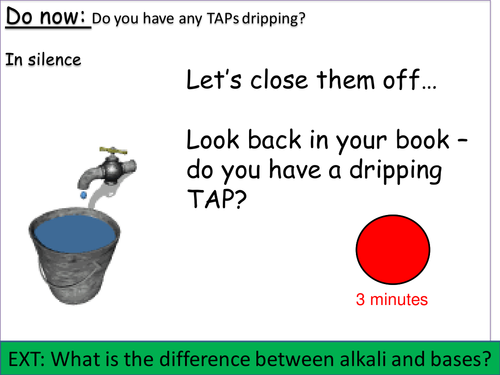












TOPIC 1 KEY CONCEPTS OF CHEMISTRY PAPER 1 and PAPER 2- NEW for SEPTEMBER 2017
OLD VERSION
Edexcel CC5 Ionic bonding for the new 9-1 GCSE
Edexcel CC6 Covalent bonding for the new 9-1 GCSE
Edexcel CC7 Types of substance for the new 9-1 GCSE
Learning objectives:
LESSON 1
To know the term ‘bond’
To be able to describe how ions can form either anions and cations
To explain how an ionic bonds are formed between atoms
To be able to calculate the number of protons, neutrons and electrons in simple ions
LESSON 2:
To know what an ionic lattice is
To be able to explain the use of endings –ide and –ate in the names of compounds
To understand how to deduce the formulae of ionic compounds given the ions
LESSON 3:
To know what particles and forces are present in ionic compounds
To be able to explain why ionic compounds have high melting and boiling points
To understand why ionic compounds conduct electricity when they are liquids but not when they are solid
LESSON 4:
To know how covalent bonds are formed
To be able to explain how a covalent bond is formed using dot and cross diagrams
To understand how to work out molecular formulae
LESSON5:
To know how covalent bonds are held together
To be able to explain the properties of typical covalent compounds
To understand that simple polymers consist of large molecules containing chains of carbon atoms
LESSON 6:
To know the structures of diamond, graphite, buckminster fullerene and graphine
To be able to explain some of their uses and describe their properties
To understand and explain the properties in terms of their structures
LESSON 7:
To know the physical properties of metals and non-metals
To be able to explain how the particles are arranged in metals
To understand how to explain the properties of a metal in term of its bonding and structure
LESSON 8:
To know the what different types of structure and bonding models are used to describe substances
To be able to describe how these models result in different physical properties
To explain the limitations of these models
All extension questions available on each slide
Answers all underneath each slide
Support also available where necessary
AfL sections and mini quizzes
Reducing the need for photocopying
Main topics include:
See individual uploads
All relating to specification (any pictures used have all been taken from the internet and I am not trying to claim rights to any pictures or information used)
Enjoy !!!!
Please leave a comment and rate
OLD VERSION
Edexcel CC5 Ionic bonding for the new 9-1 GCSE
Edexcel CC6 Covalent bonding for the new 9-1 GCSE
Edexcel CC7 Types of substance for the new 9-1 GCSE
Learning objectives:
LESSON 1
To know the term ‘bond’
To be able to describe how ions can form either anions and cations
To explain how an ionic bonds are formed between atoms
To be able to calculate the number of protons, neutrons and electrons in simple ions
LESSON 2:
To know what an ionic lattice is
To be able to explain the use of endings –ide and –ate in the names of compounds
To understand how to deduce the formulae of ionic compounds given the ions
LESSON 3:
To know what particles and forces are present in ionic compounds
To be able to explain why ionic compounds have high melting and boiling points
To understand why ionic compounds conduct electricity when they are liquids but not when they are solid
LESSON 4:
To know how covalent bonds are formed
To be able to explain how a covalent bond is formed using dot and cross diagrams
To understand how to work out molecular formulae
LESSON5:
To know how covalent bonds are held together
To be able to explain the properties of typical covalent compounds
To understand that simple polymers consist of large molecules containing chains of carbon atoms
LESSON 6:
To know the structures of diamond, graphite, buckminster fullerene and graphine
To be able to explain some of their uses and describe their properties
To understand and explain the properties in terms of their structures
LESSON 7:
To know the physical properties of metals and non-metals
To be able to explain how the particles are arranged in metals
To understand how to explain the properties of a metal in term of its bonding and structure
LESSON 8:
To know the what different types of structure and bonding models are used to describe substances
To be able to describe how these models result in different physical properties
To explain the limitations of these models
All extension questions available on each slide
Answers all underneath each slide
Support also available where necessary
AfL sections and mini quizzes
Reducing the need for photocopying
Main topics include:
See individual uploads
All relating to specification (any pictures used have all been taken from the internet and I am not trying to claim rights to any pictures or information used)
Enjoy !!!!
Please leave a comment and rate
Something went wrong, please try again later.
This resource hasn't been reviewed yet
To ensure quality for our reviews, only customers who have purchased this resource can review it
Report this resourceto let us know if it violates our terms and conditions.
Our customer service team will review your report and will be in touch.
£10.00
